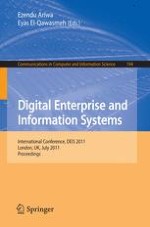This volume constitutes the refereed proceedings of the International Conference on Digital Enterprise and Information Systems, held in London during July 20 - 22, 2011. The 70 revised full papers presented were carefully reviewed and selected. They are organized in topical sections on cryptography and data protection, embedded systems and software, information technology management, e-business applications and software, critical computing and storage, distributed and parallel applications, digital management products, image processing, digital enterprises, XML-based languages, digital libraries, and data mining.
